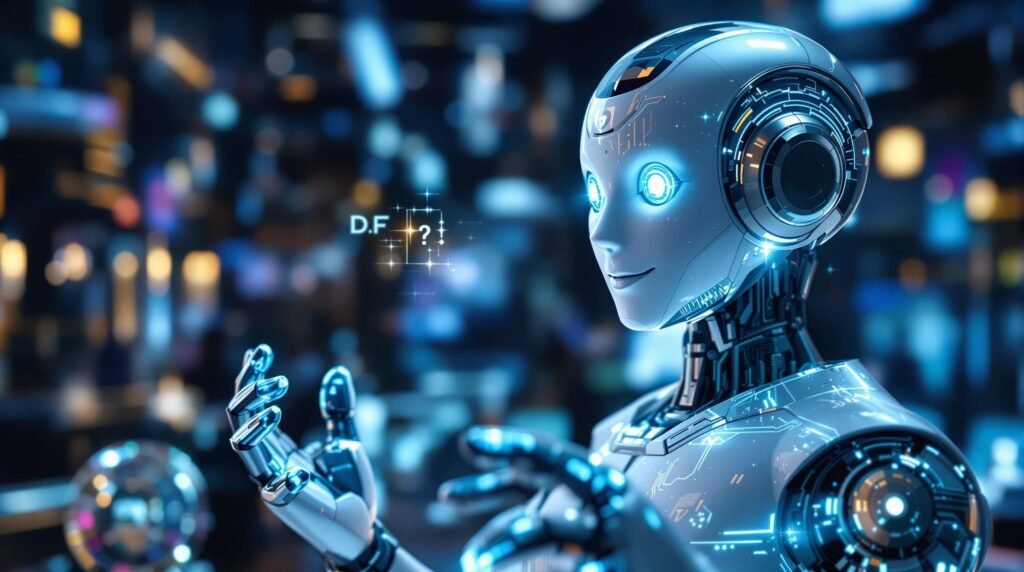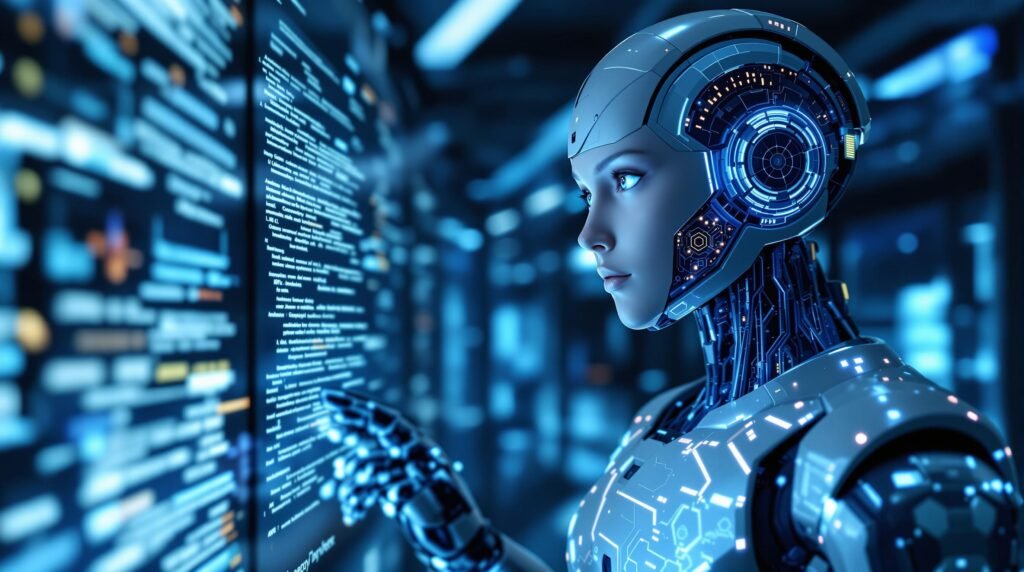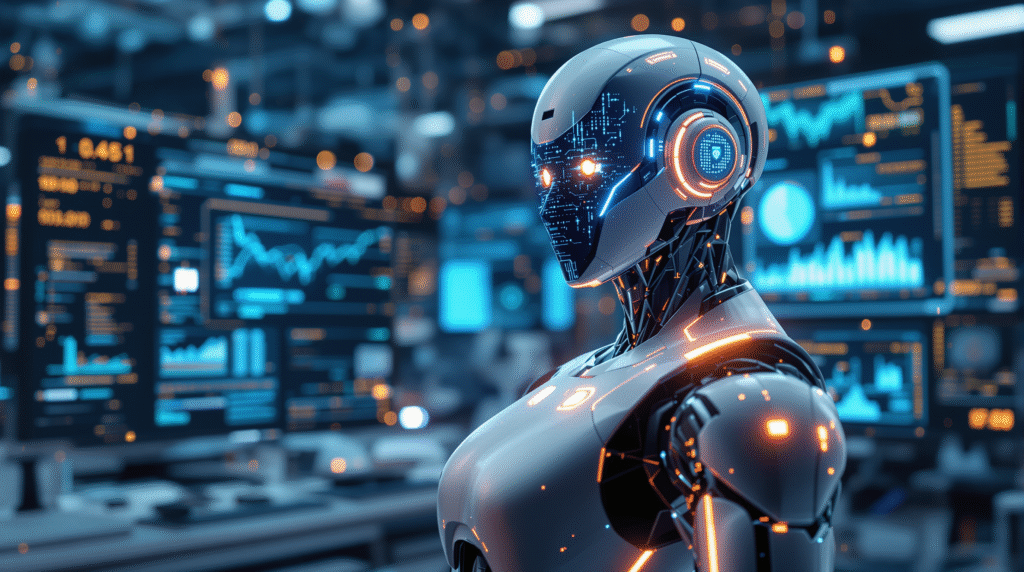Introduction to AI Agents
Artificial intelligence (AI) is a field of computer science that enables machines to perform tasks requiring intelligence, such as understanding language, recognizing images, or making decisions. One of the most important concepts in AI is the agent. An AI agent is a program or system that can independently observe its environment, analyze collected data, and make decisions aimed at achieving a specific goal.
AI agents are the foundation of many modern technological solutions. We encounter them in voice assistants, autonomous vehicles, recommendation systems, and smart homes. Thanks to AI agents, it is possible to automate many processes, personalize services, and quickly respond to changing conditions.
Understanding how an AI agent works is the first step to discovering practical applications of artificial intelligence and starting your own journey with this technology.
Key Elements of How an AI Agent Works
For an AI agent to operate effectively, it must have several basic elements that enable it to interact with its environment and make decisions. The most important of these are:
Perception (observation) – the agent receives information from its environment using sensors, cameras, microphones, or other data sources. An example might be a thermometer measuring room temperature or a microphone recording voice commands.
Analysis (data processing) – the agent processes the collected information, recognizes the situation, and evaluates possible courses of action. At this stage, algorithms, decision rules, or machine learning models are used.
Decision – based on the analysis, the agent selects the best action that will bring it closer to achieving its goal. This could be turning on the heating, sending a response to a user’s question, or changing a vehicle’s route.
Action – the agent performs the chosen activity, affecting its environment. This closes the agent’s action cycle, which can be repeated many times in response to changing conditions.
These four elements—perception, analysis, decision, and action—form the basic framework of every AI agent. Depending on the level of advancement, an agent can be very simple (e.g., reacting to only one type of stimulus) or complex, using advanced machine learning techniques and communication with other agents.
The Life Cycle of an Agent: Observation, Analysis, Action
Every AI agent operates according to a repeatable cycle that allows it to effectively respond to changing conditions in its environment. This agent life cycle consists of three main stages: observation, analysis, and action.
Observation is the moment when the agent gathers data from its environment. This could be reading the temperature, analyzing an image from a camera, listening for voice commands, or retrieving information from the internet. The more and better-quality data the agent receives, the better it can understand the situation it is in.
Analysis involves processing the collected information. The agent compares current data with previous experiences, uses built-in rules or machine learning models to assess which actions are possible and which will be most beneficial. At this stage, the agent can predict the outcomes of its decisions and choose those that best achieve its goal.
Action is the stage where the agent makes a decision and performs a specific activity. This could be sending a response to a user, turning on a device, changing driving direction, or triggering an alarm. After performing the action, the agent returns to the observation stage, thus closing the cycle and preparing to react to new stimuli.
This life cycle makes the AI agent a dynamic system, capable of continuously adapting to its environment and making accurate decisions even in changing conditions.
Practical Examples of AI Agent Applications
AI agents are used in many areas of life and the economy, often making everyday activities easier or automating complex processes. Here are a few practical examples:
Voice assistants (e.g., Siri, Google Assistant, Alexa) – recognize voice commands, answer questions, manage calendars, and control smart homes. Each user command is a new cycle for the agent: observation (listening), analysis (intent recognition), and action (task execution).
Autonomous vehicles – analyze data from cameras, radars, and sensors to make driving decisions, avoid obstacles, or stop at traffic lights. The agent in the car constantly observes the environment, analyzes the road situation, and takes actions to ensure safety.
Recommendation systems (e.g., Netflix, Spotify) – analyze user history, predict preferences, and suggest new movies, series, or music tracks. The agent observes user choices, analyzes data, and generates personalized recommendations.
Smart homes – AI agents control lighting, heating, alarms, or household appliances, adjusting their operation to the presence of residents, time of day, or weather conditions.
Customer service – chatbots and virtual assistants answer customer questions, help solve problems, and speed up purchasing processes.
Thanks to AI agents, many processes become more efficient, faster, and more convenient for users. Their applications are constantly expanding, and the possibilities for development are practically limitless.
Simple AI Agent – Example in Python
The best way to understand how an AI agent works is to see it in practice. Below is a simple example of an agent written in Python that decides whether to turn on the light in a room based on the brightness level.
Let’s assume the agent receives information about the current brightness (e.g., from a light sensor) and has a set threshold below which it should turn on the light. If the brightness is lower than this threshold, the agent decides to turn on the light; otherwise, the light remains off.
python
Copy Code
class LightAgent:
def __init__(self, brightness_threshold):
self.brightness_threshold = brightness_threshold
def observe_and_act(self, current_brightness):
if current_brightness < self.brightness_threshold:
return "Turn on light"
else:
return "Light turn"
# Przykład użycia
agent = LightAgent(brightness_threshold=50)
print(agent.observe_and_act(current_brightness=30)) # Turn on light
print(agent.observe_and_act(current_brightness=70)) #Light turnThis simple agent illustrates the basic cycle: observation (reading brightness), analysis (comparing with the threshold), and action (turning the light on or off). Such solutions are used, among others, in smart homes, where lighting automation helps save energy and increase user comfort.
The Role of Machine Learning in Agent Operation
Although simple AI agents operate according to fixed rules, machine learning is increasingly used, allowing agents to learn from experience and historical data. Thanks to this, the agent can make better and better decisions over time, adjusting its actions to changing conditions and user preferences.
An example might be an agent recommending movies on a streaming service. At first, the agent may suggest the most popular titles, but over time, by analyzing the user’s choices, it begins to better understand their taste and offer more accurate recommendations. For this purpose, the agent uses machine learning algorithms that analyze behavior patterns and predict what a given person might like.
Machine learning also allows agents to recognize speech, images, and even user emotions. Thanks to this, AI agents are becoming more advanced and versatile, and their applications include not only simple automation but also complex decision support systems in business, medicine, or education.
Challenges and Limitations of AI Agents
Although AI agents offer many benefits and are used in more and more fields, their implementation and development come with certain challenges and limitations. One of the main problems is the quality and availability of data. For an AI agent to make accurate decisions, it needs reliable, up-to-date, and properly processed information. Lack of or poor-quality data can lead to incorrect decisions or even undesirable outcomes.
Another challenge is interpreting complex situations and unpredictable changes in the environment. Simple agents operating according to rigid rules may not cope in dynamic environments where a flexible approach and the ability to learn on the fly are required. In such cases, it is necessary to use more advanced techniques, such as machine learning or deep neural networks.
An important limitation is also security and privacy. AI agents often process users’ personal data, so they must be designed with privacy protection and compliance with regulations such as GDPR in mind. Additionally, agents can be vulnerable to cyberattacks, which can lead to system takeover or data leaks.
The last challenge is user trust. For AI agents to be widely accepted, they must operate in a predictable, transparent, and ethical manner. Users should understand how the agent makes decisions and have the ability to control its operation.
Summary and Next Steps
AI agents are a key element of modern artificial intelligence, enabling automation, personalization, and improvement of many processes in everyday life and business. We have already learned the basic principles of agent operation, their life cycle, application examples, as well as the challenges they face.
If you want to develop in this field, it is worth starting by learning the basics of programming (preferably in Python), getting to know popular AI libraries, and experimenting with simple agent projects. As you gain experience, you can move on to more advanced topics such as machine learning, natural language processing, or building multi-agent systems.
Remember that the world of AI agents is developing very dynamically, and the possibilities for their application are constantly growing. It is worth keeping up with the news, using online courses, and actively participating in the AI community to stay up to date with the latest trends and technologies.
Would you like me to prepare a list of recommended learning materials or an example AI agent project?
Intelligent Agents: How Artificial Intelligence Is Changing Our World
Agents AI: A New Era of Automation and Intelligent Decision-Making in Business
Ethical Challenges in Artificial Intelligence Development: What Should an AI Engineer Know?


